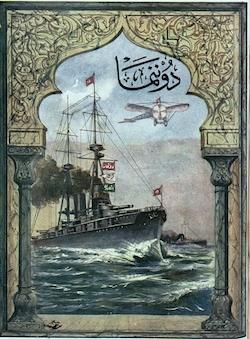
Having long held maritime supremacy, the Ottoman Navy entered a period of decline from the 18th century onwards. Naval conquests ceased, and defeats against rival powers at sea became increasingly frequent, culminating in the catastrophic Battle of Çeşme in 1770, resulting in the total annihilation of the fleet. In the 19th century, however, concerted efforts were made to rejuvenate the navy. Following the devastating defeat at the Battle of Navarino in 1827, Sultan Mahmud II prioritized the modernization of the navy, procuring the first steamships from Europe for the Ottoman Navy.
During the reign of Sultan Abdülaziz (1861-1876), naval reforms accelerated significantly. This era coincided with revolutionary progress in global shipbuilding. Having encountered modern warships for the first time in the Crimean War, the Sublime Porte recognized the imperative of not lagging behind in the naval arms race. In addition to commissioning ships from British, French, and Austrian shipyards, local assembly took place at shipyards in Istanbul, Izmit, Gemlik, Mudanya, Çanakkale, Sinop, Crete, Basra, and Russe.
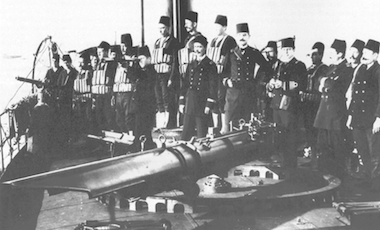
By the end of Abdülaziz's reign, the Ottoman navy boasted 21 warships and 173 other vessels, establishing itself as the world's third-largest navy after the British and the French. However, this accomplishment came at a significant cost, exacerbating the strain on the already beleaguered economy.
Following the reign of Sultan Abdülaziz, the Ottoman navy entered a state of neglect. His successor, Sultan Abdülhamid II (1876-1909), exhibited disinterest in naval matters, primarily stemming from his suspicion of reformist admirals involved in Abdülaziz's removal. Additionally, Abdülhamid considered naval expenditures wasteful, asserting that the navy proved ineffective during the Turkish-Russian War of 1877-78. Consequently, Abdülhamid directed all ships to remain anchored in the Golden Horn, prohibiting engine operation, departure from bases, or shooting practices without his permission. Scarce resources further hindered adequate maintenance, leading to the rapid obsolescence of the fleet.
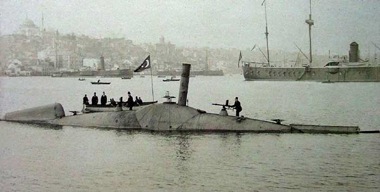
Notwithstanding Abdülhamid's responsibility for the prolonged inactivity and fleet decay, his reign witnessed the Ottoman Empire's acquisition of two submarines. In 1885, Greece purchased the initial Nordenfeldt class submarine from Bolinders in Stockholm. Seeking a strategic advantage, Abdülhamid acquired the second and third Nordenfeldt class submarines for 11,000 pounds sterling each, despite Major Halil Bey's report from the Ottoman military attaché in Berlin cautioning against their use in strong-current waters without enhancements in speed and torpedo capacity. Assembled at the Taşkızak Naval Shipyard in Istanbul, the submarines—Abdülhamid (launched on 6 September 1886) and Abdülmecid (launched on 4 August 1887)—encountered stability issues and vulnerability on the surface. Nevertheless, both submarines underwent successful testing, with Abdülmecid earning the distinction of being the first submarine in naval history to fire a torpedo while submerged.
Regrettably, the fate of these submarines mirrored that of the broader Ottoman fleet. Despite a brief testing period in Istanbul and Izmit, they joined the anchored vessels in the Golden Horn, succumbing to neglect.
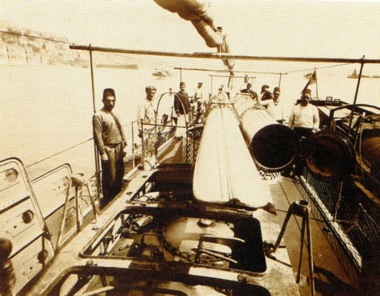
The navy's inertia persisted until the Turco-Greek War of 1897 prompted a reluctant departure from the Golden Horn to Çanakkale to protect the straits. However, the endeavour turned disastrous, as the long period of inactivity left the fleet ill-equipped for movement, let alone battle. Of the six vessels attempting to sail from the Golden Horn, one suffered boiler explosions, another began taking on water, and the rest lost direction in the rain. Lacking experience, sailors were paralyzed by indecision as admirals struggled to formulate a cohesive course of action.
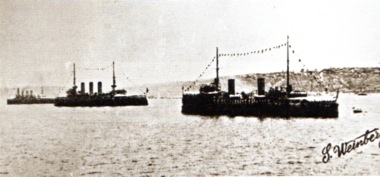
Two weeks after the conclusion of the Turkish-Greek War, precisely on 21 June 1897, Admiral Hasan Rami Pasha, Commander of the Navy, presented a comprehensive report to the Sublime Porte. The report underscored the pressing necessity to rejuvenate the naval forces through the acquisition of new vessels from European shipyards. Abdülhamid, in concordance with this recommendation, did not interpose objections, recognizing the imperative to bolster naval capabilities, particularly for the protection of the Dardanelles. Subsequent to this decision, a procurement initiative was instigated, encompassing the acquisition of new ships and the refurbishment of existing ones. Notably, in 1903, two warships, namely Hamidiye and Mecidiye, were procured from Britain and the United States, respectively.
Despite these endeavours during the later years of Abdülhamid's reign, the naval fleet remained in a state of disrepair when the constitution was declared in 1908. The majority of vessels in service were aged between 20 and 40 years, rendering the navy inept at safeguarding not only the Turkish homeland but also the overseas territories. Officer training took place on moored vessels, devoid of maneuvers and drills. Many sailors had not even set eyes on the ships they served on, notwithstanding the receipt of their salaries.
In 1909, a pivotal shift ensued with the ascension of Sultan Mehmet Reşad to the Ottoman throne. Recognizing the imperative for the fortification and revitalization of the navy, the Sultan was confronted with the predicament that the Empire lacked proficient naval experts.
British Naval Mission
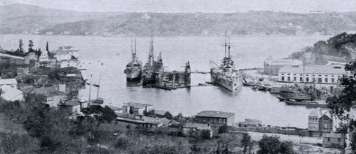
For the enhancement of his naval forces, Sultan Mehmet Reşad sought assistance from Britain, prompting the dispatch of a naval mission to Turkey. Admiral Douglas Gamble, the leader of the inaugural British naval mission, commenced comprehensive reforms and fortification efforts within the navy during his tenure spanning from January 1909 to February 1910.
Under Gamble's direction, the fleet underwent organizational restructuring, a reduction in officer numbers, and the dispatch of young naval officers to Britain for training. As part of the reform initiative, the initial operational deployment of the active fleet occurred in the Sea of Marmara on 27 May 1909, followed by a significant maneuver conducted in the Mediterranean Sea in September of the same year.

Admiral Gamble encountered a series of conflicts with various Ottoman ministers concerning fleet organization and financial matters. He staunchly advocated for sole decision-making authority in these domains. Subsequent to profound disagreements, he tendered his resignation on 26 January 1910.
Admiral Hugh Pigot Williams succeeded Admiral Gamble, assuming office from May 1910 to February 1911. Admiral Williams continued with maneuvers in the Sea of Marmara during his tenure, coinciding with the incorporation of two warships ordered from Germany into the fleet. However, apprehensions within the Sublime Porte escalated as concerns mounted over the delegation of modernization and expansion efforts to foreign entities. Consequently, the Ministry of Navy resolved to "appoint an independent and fully authorized Turkish officer who will take over the command of the fleet in case of war." On 2 January 1911, Colonel Tahir Bey was appointed as the Vice Commander of the Navy. Admiral Williams, who was in London at the time, resigned in protest. His return to Turkey was to be marked by his presence aboard the Irresistible, which forced the Dardanelles on 18 March 1915.

After Williams' tenure, the Ministry of Navy did not employ British officers for some time. At one point, Admiral Gamble was approached again, but he rejected the offer. Acting upon the counsel of the British Admiralty, Admiral Arthur Limpus arrived in Istanbul on 6 June 1912. Limpus conducted a fleet maneuver, extending as far as Beirut, which proved highly successful during that period. However, his program faced interruptions due to the Turkish-Italian and Balkan Wars.
In 1914, as the Ottoman Empire formed an alliance with Germany and command of the navy was entrusted to a German Admiral, Limpus concluded his service in Turkey. This marked the termination of a century-long British influence on the Turkish navy. The British naval mission played a pivotal role in rejuvenating the fleet and naval organization. Cemal Pasha, the Minister of Navy, underscored in his memoirs: "It is my moral obligation to emphasize once again that Admiral Limpus, along with his officers and all the British engineers and personnel who contributed to the rehabilitation of the shipyards in the Golden Horn, conscientiously fulfilled their duties."
The Navy Association
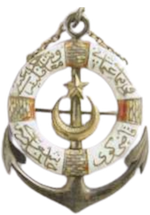 Given the imperative for the Navy to acquire new warships, the government devised a ten-year procurement program, earmarking a budget of five million liras. However, it swiftly became apparent that this financial provision was insufficient. Concurrently, Greece was fortifying its naval capabilities with notable vigour, having recently acquired a 10,000-ton heavy cruiser from Italy, christened Averoff.
Given the imperative for the Navy to acquire new warships, the government devised a ten-year procurement program, earmarking a budget of five million liras. However, it swiftly became apparent that this financial provision was insufficient. Concurrently, Greece was fortifying its naval capabilities with notable vigour, having recently acquired a 10,000-ton heavy cruiser from Italy, christened Averoff.
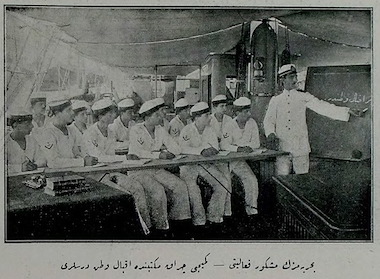
On 14 July 1909, a cadre of influential merchants, led by Yağcızade Şefik Bey, established Donanma Cemiyeti (Navy Association). The primary objective of this association was to mobilize financial support from the citizenry in bolstering the government's endeavours to procure new battleships. In cafes, schools, and markets, citizens contributed monetary sums to aid the Turkish Navy. To incentivise this philanthropic campaign, generous donations were acknowledged with the bestowal of a medal known as the Donanma İane Madalyası (Navy Donation Medal).
Nejat Gülen quotes two contemporaries, who wrote in their memories how the Navy Association was raising funds. Muammer Tuksavul, who was 10 years old then, was reading a patriotic poem first, and “…when the poem was finished, I went down from the stage and together with a friend of mine we took the donations box of the Navy Association, which was decorated with ribbons, to the guests. Ladies were seated on the right and gentlemen on the left. In 5-10 minutes to box was so heavy that I could hardly carry it. Mecidiye coins and gold were flowing in it. Especially the ladies were generous. They were saying ‘good on you, boy’ and putting their gold coins, jewels, necklaces in the box.”
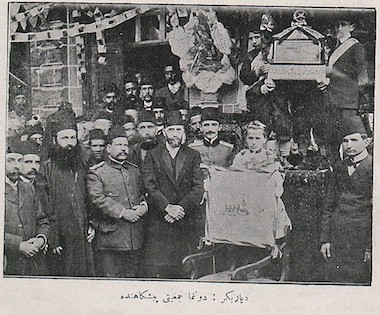
Admiral Akif Büyüktuğrul wrote: “I was a child then. At the theatres in Şehzadebaşı, when it was the interlude, they were taking a table to the stage and placing a large bowl on it. Some people like the late poet Hamdullah Suphi were saying things like ‘Greeks have bought the Averoff! We are losing the homeland!’ and all the people were then putting whatever they have in that bowl. Soon the bowl was filled with gold and silver.”
In addition to the accrued donations, the government also assigned fresh resources to the association. Revenues from taxes on matches and cigarette papers were directly allocated to the Navy Association, which was granted permission to conduct lotteries and gather special donations during religious holidays.
Funds were available, and the government sought to procure a dreadnought comparable to the Greek Averoff. Following an unsuccessful attempt to this end, the Ministry of Navy acquired two antiquated warships from Germany, each costing 1 million 70 thousand liras. A German admiral transported the vessels to the Dardanelles, where they were taken over by their Turkish crew. These two warships, named Barbaros and Turgut Reis, dropped anchor in front of the Dolmabahçe Palace on 21 August 1910. Furthermore, orders for four new destroyers were placed with German shipyards, and these vessels, amounting to 480 thousand liras, joined the Turkish fleet in 1912. They were christened Yadigar-ı Millet, Muavenet-i Milliye, Numune-i Hamiyet and Gayret-i Vataniye.
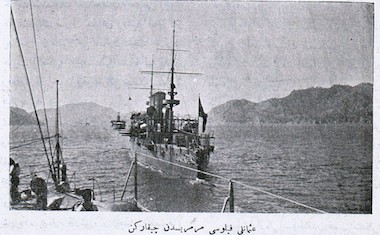
In 1911, notwithstanding the introduction of new vessels and the ongoing restructuring efforts of the British naval mission within the Turkish Navy, the latter remained inferior to its Greek counterpart, asserting dominance in the Aegean Sea. A formidable Turkish naval force at that juncture could have thwarted Italian advances towards Tripolitania, forestalled the invasion of Aegean islands, and provided critical naval artillery support to the forces in West Thrace.
During December 1912 and January 1913, the Turkish Navy ventured beyond the Dardanelles, encountering the Greek Navy near the Island of Imbros and subsequently around Mudros Island. On both occasions, the Turkish fleet was compelled to retreat to the confines of the straits. The sole noteworthy accomplishment of the Turkish Navy during the Balkan Wars materialized through the gallant exploits of the cruiser Hamidiye. Navigating the Eastern Mediterranean for seven and a half months, the vessel disrupted Greek Navy operations. Although unable to alter the course of the conflict, the global community closely monitored the voyage of the Hamidiye and its captain, Rauf Bey, with profound admiration.
Dreadnoughts Seized by Britain
No vessel within the Turkish Navy could rival the Averoff, prompting Turkey's determination to acquire dreadnoughts. The Ministry of Navy initiated the procurement process with the British shipyard Vickers Ltd. for a 27,500-ton vessel to be named Reşadiye, at a cost of 2.3 million liras, payable in instalments. A designated commission, under the leadership of Major Vasıf Ahmet Bey, was established to oversee the construction of the dreadnought, and this commission travelled to Britain in 1912.
Simultaneously, a naval competition between Argentina and Brazil resulted in the latter commissioning a dreadnought from the British shipyard Armstrong Whitworth in the spring of 1911, intended to be named Rio de Janeiro. However, by 1913, the disputes between the two nations were resolved, leading Brazil to discontinue payments. Consequently, Turkey assumed the contract for the vessel, renaming it Sultan Osman. Both dreadnoughts were slated for delivery by mid-1914. In 1914, a third warship, to be named Fatih, was commissioned from Vickers Ltd.
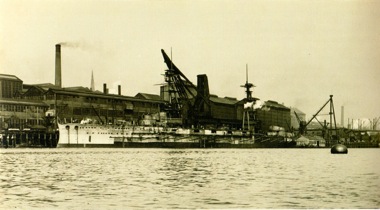
The progress of construction fell short of the Turks' expectations, with Sultan Osman being completed but awaiting the installation of its weapon systems. A ceremony on 3 September 1913, marked the launch of Reşadiye into the sea, with Naile Hanım, the daughter of Turkish ambassador Tevfik Pasha in London, officiating by breaking a bottle of rose water on the dreadnought. Concurrently, Sultan Osman had been fully paid for, with only the final instalments outstanding for Reşadiye.
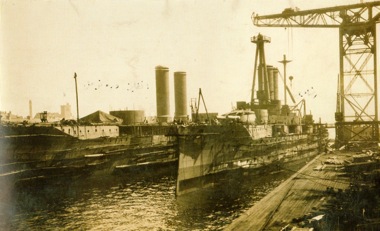
On 8 January 1914, Captain Rauf Bey and his team travelled to Newcastle to oversee the concluding stages of Sultan Osman's construction and its subsequent journey to Turkey. The incorporation of new weapon systems, adjustment of ship facilities to Turkish standards, and the testing of engines and weapons were imperative tasks. However, Rauf Bey expressed dissatisfaction with the sluggish pace of the work, exacerbated by the imminent receipt of new battleships by the Greeks from the United States. Furthermore, the weaponry did not meet his expectations. In a letter dated 4 February 1914, he communicated to Istanbul:
"The contract for Sultan Osman does not stipulate any clauses mandating the equipping of the ship with anti-zeppelin guns. It would be fitting for Sultan Osman to be furnished with four pieces of 76mm guns, which have been successfully tested on Reşadiye at Vickers shipyard. If the Ministry of Navy does not raise objections, it would be advisable to liaise with the Armstrong shipyard and place an order accordingly in accordance with our requirements."
In July of 1914, amidst the ongoing testing of dreadnoughts in British waters and a growing impatience among the Turks, Rauf Bey sought permission to ceremoniously raise the Turkish flag on the Sultan Osman. This event was scheduled for 2 August 1914, at 8 o’clock in the morning, following the arrival of the Turkish crew in Newcastle.
There was a reason why the British shipyards were so slow. As the specter of war loomed, the British government hesitated to allow such formidable vessels to depart its waters, particularly given Turkey's burgeoning alignment with Germany. Winston Churchill, serving as the First Lord of the Admiralty, cognizant of the potential diplomatic ramifications, nevertheless deemed it too perilous to permit these warships to potentially engage the Royal Navy.
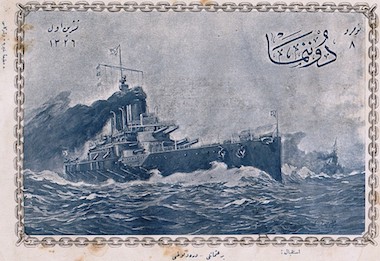
On the morning of 1 August 1914, officials from the Armstrong shipyard convened with local military officers. Later that same day, the docks teemed with British troops. Mere hours prior to the scheduled hoisting of the Turkish flag on the Sultan Osman, the vessel was confiscated, compelling the Turkish crew to hastily abandon ship. On 3 August, 1914, Churchill formally announced that the British government had imposed an embargo on the two warships. Subsequently, when Britain declared war the following day, both vessels were commandeered without compensation due to the Ottoman Empire's alliance with Germany. Rauf Bey, Vasıf Ahmet Bey, and the Turkish crew departed Britain empty-handed, arriving in Istanbul on 22 August, 1914. On 5 August 1914, the Ottoman Ambassador to London, Tevfik Pasha, sent a telegram to Istanbul:
"When I was informed that the British government has seized two warships of ours and asked our officers to leave, I went to see the under-secretary of the Foreign Office. He said that these measures have been deemed necessary by the Admiralty. When I asked if it is a definitive seizure, he said that it was not an act that obliges the British government to buy the ships, and the government is free to buy them or to return them to us in the future. I tried to question the legitimacy of this arbitrary action, but he didn’t want to discuss and simply repeated what he said before."
The apprehension of two dreadnoughts by Britain elicited a profound reaction in Istanbul. Minister of Navy, Cemal Pasha, registered his protest with Admiral Limpus, while Enver Pasha characterised this action as unequivocal evidence of "British treachery." Concurrently, Reşadiye was commissioned into the Royal Navy under the name Erin, and Sultan Osman assumed the designation Agincourt.
Goeben and Breslau
Captain Rauf Bey and his contingent were en route from Britain to Turkey aboard the vessel Reşit Paşa when, on their journey, two German battle cruisers, Goeben and Breslau, entered the Dardanelles. These formidable warships comprised the Mittelmeerdivision (Mediterranean Division) of the German Navy, commanded by Admiral Wilhelm Souchon. The British fleet was in pursuit of these vessels, which had sought permission to enter the Turkish straits.
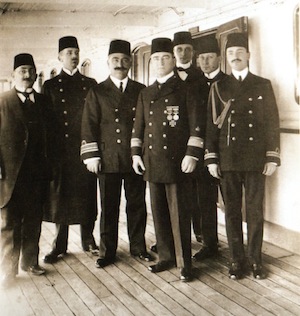
After brief consultations between Enver Pasha and the German Military Mission in Istanbul, the former granted permission for the German battle cruisers to traverse the Dardanelles. Negotiating the mine barriers safeguarding the straits, Goeben and Breslau were guided to Istanbul, where, on 16 August 1914, they underwent a diplomatic maneuver to be incorporated into the Turkish Navy. The Sublime Porte officially declared that the two ships had been "acquired" from Germany. Ottoman flags were ceremoniously raised on both vessels, and German sailors were provided with local headgear (fez). Goeben was rechristened Yavuz, while Breslau assumed the name Midilli. Throughout the duration of the war, these ships were operated by German officers and sailors attired in Turkish uniforms.
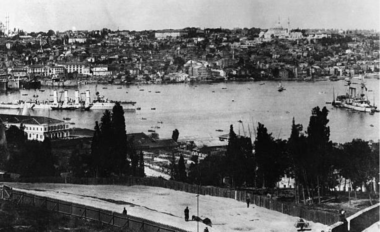
The consignment of two German vessels to the Turkish Navy elicited protest from the Allied powers, particularly from Britain. Conversely, the arrival of Yavuz and Midilli was a cause for celebration not only for Enver Pasha but also for the entire city of Istanbul. On 9 September 1914, Admiral Souchon assumed command of the Turkish fleet, marking the commencement of German influence on the Turkish Navy throughout the duration of the war. Colonel Arif Bey assumed the role of the second fleet commander.
Admiral Souchon's initial actions involved the augmentation of the navy's training program, streamlining personnel numbers, and assigning a German officer to each warship. These German officers were tasked with overseeing training and assuming command in lieu of the Turkish officers when required.
Furthermore, Admiral Souchon undertook a comprehensive reorganization of the Turkish fleet. At the onset of the war, the fleet's structure was as follows:
First Squadron
Yavuz (Col. Richard Ackermann) | Barbaros Hayreddin (Col. Muzaffer Bey) |Turgut Reis (Capt. Namık Hasan Bey) | Mesudiye (Maj. Arif Nebi Bey).
Second Squadron
Midilli (Col. Paul Kettner) | Hamidiye (Capt. Vasıf Muhiddin Bey) | Peyk-i Şevket (Col. İbrahim Cevat Bey) | Berk-i Satvet (Maj. Hamdi Bey).
First Destroyer Squadron
Numune-i Hamiyet (out of service) | Muavenet-i Milliye (Maj. A. Saffet Bey) | Gayret-i Vataniye (Capt. Cemil Ali Bey) | Yadigar-ı Millet (Capt. Rauf Sait Bey).
Second Destroyer Squadron
Samsun (Capt. Nezir Abdullah Bey) | Taşoz (Capt. Tevfik Halit Bey) | Basra (out of service) | Yarhisar (Capt. Ahmet Hulusi Bey).
First Torpedo Boat Squadron
Draç (Capt. Aziz Mahmut Bey) | Kütahya (Capt. İbrahim Halil Bey) | Musul (Capt. Ahmet Naim Bey) | Akhisar (out of service).
Second Torpedo Boat Squadron
Sultanhisar (Capt. Rıza Mehmet Bey) | Demirhisar (Capt. Ahmet Şefik Bey) | Sivrihisar (Capt.Mehmet Sabri Bey) | Hamidabad (Capt. İbrahim Kerim Bey).
Mine Group (Maj. Nazmi Emin Bey)
Yunus (Capt. Ahmet Mahmut Bey) | Nusrat (Capt. Hakkı Bey) | İntibah (Maj. Ahmet Halit Bey) | Nilüfer (Capt. Hasan Murat Bey).
Rauf Bey's memoirs elucidate a notable discord between Admiral Souchon and Turkish officers. During this period, the Minister of Navy, Cemal Pasha, was situated in Palestine alongside the Fourth Army. According to Rauf Bey's assertions, Admiral Souchon exploited Cemal Pasha's absence to assert control over the Ministry in a manner conducive to German interests. Rauf Bey, assuming the role of Chief of the Staff of the Navy, wrote, "This admiral acknowledged none among us. He refrained from reporting to Enver Pasha, asserting his sole accountability to the German headquarters."
The War
The Ottoman Empire officially entered the First World War, when Admiral Souchon took Yavuz and Midilli to the Black Sea and bombarded the Russian ports of Odessa and Sevastopol.
"None of us did know about this. I thought that Enver Pasha must have been informed about what happened. However he swore to God that he did not have any information whatsoever about the incident. So, we entered the war as the result of a fait accompli." (Talat Pasha in his memoirs)

Despite the considerable inferiority of the Turkish Navy in comparison to those of the Allied nations, its performance during the World War surpassed its achievements in the Balkan War and made a significant contribution to Turkish war efforts. Primarily, within the Russian-dominated Black Sea, the Turkish fleet safeguarded transportation lines, notably the supply routes to the Caucasus front and the coal transportation route connecting Zonguldak and Istanbul. Additionally, it defended the Bosphorus, preventing potential incursions by the Russian Black Sea Fleet, and conducted raids on Russian coasts and supply lines. Numerous instances occurred where Turkish warships engaged with the Russian fleet in the Black Sea, resulting in the sinking of three Russian battleships with a combined tonnage of 7,900 tons.
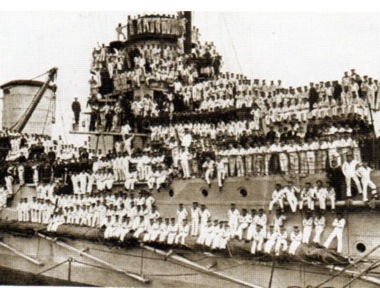
In the Sea of Marmara, the Turkish fleet protected supply lines between Istanbul and Çanakkale and engaged enemy submarines attempting to disrupt these lines. During the Gallipoli campaign, it played a significant role by laying mines and supporting Turkish land units. Out of the 16 British and French vessels (92,273 tons) sunk at the Dardanelles, 27,875 tons were sunk by German submarines in Turkish waters, 41,155 tons were sunk by mines, 13,150 tons were sunk by the destroyer Muavenet-i Milliye, 800 tons were sunk by the torpedo boat Sultanhisar, and an additional 1,115 tons were sunk by patrol boats.
At the Sinai front, amidst the assault on the Suez Canal, Turkish naval vessels engaged British naval units utilizing mines. In Mesopotamia, alongside mine-laying operations, a river flotilla was actively employed. Throughout these operations, Turkish sailors collaborated with German experts, significantly enhancing Turkish naval capabilities.
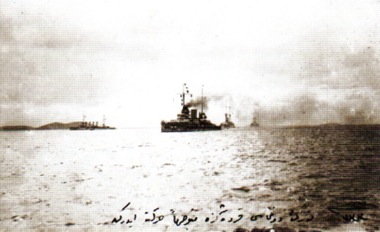
The Turkish fleet incurred substantial losses during the conflict. Beyond the two dreadnoughts appropriated by the British government pre-war, the Turkish Navy witnessed the demise of battleships totaling 32,218 tons. This toll encompassed the vessels Mecidiye, Yarhisar, Mesudiye, Barbaros, Gayret-i Vataniye, Yadigar-ı Millet, and Midilli. Additionally, 7,124 tons of auxiliary vessels were lost, and seven warships, amounting to 26,309 tons, sustained damage.
In September 1917, Admiral Souchon returned to Germany, succeeded by Admiral Hubert von Rebeur-Paschwitz. The latter orchestrated a raid on the islands of Imbros and Lemnos, culminating in failure, with Midilli succumbing to a mine and Yavuz barely surviving substantial damage, eventually limping back to the Dardanelles. This marked one of the concluding endeavours of the Turkish fleet.
Turkey's involvement in the war concluded with the armistice signed at the port of Mudros on Lemnos on 30 October 1918. On 3 November 1918, Navy Commander Arif Pasha issued the order to lower all flags on battleships stationed at the Golden Horn in Istanbul. With the descent of the ensign, the Imperial Ottoman Navy ceased to exist. In the waning weeks of 1918, the battleships were disarmed in compliance with the armistice terms, as the Allied fleet anchored at the Bosphorus.
![]()
Sources consulted:
- Baş, E., “Türk Tarihinde Yavuz Zırhlısının Rolü” (The Role of Battleship Yavuz in Turkish History), Piri Reis Araştırma Merkezi, Istanbul, 2008.
- Cemal Paşa, “Hatıralar” (Memoirs), İş Bankası Kültür Yayınları, Istanbul, 2001.
- Gülen, N., “Dünden Bugüne Bahriyemiz” (Our Navy from the Past to the Current Day), Kastaş Yayınları, Istanbul, 1988.
- Güvenç, S., “Osmanlıların Drednot Düşleri: Birinci Dünya Savaşı’na Giden Yolda” (The Ottomans’ Dreadnaught Dreams: On the Road to the First World War), Türkiye İş Bankası Kültür Yayınları, Istanbul, 2011.
- Kabacalı, A. (ed), “Talat Paşa’nın Anıları” (Memoirs of Talat Paşa), İş Bankası Kültür Yayınları, Istanbul, 2000.
- Kocahanoğlu, O.S. (ed), “Rauf Orbay’ın Hatıraları” (Memoirs of Rauf Orbay), Temel Yayınları, Istanbul, 2005.
- Langensiepen, B. and Güleryüz, A., “The Ottoman Steam Navy”, Conway Maritime Press, London, 1995.
- Mütercimler, E., “İmparatorluğun Çöküşüne Denizden Bakış” (A Naval Look at the Collapse of the Empire), Toplumsal Dönüşüm Yayınları, Istanbul, 2003.
- Official History, “Birinci Dünya Savaşı’nda Türk Harbi – Deniz Harekatı” (Turkish Battles in the First World War – Naval Operations), Genelkurmay Yayınları, Ankara, 1976.
- Öke, M.K. and Mütercimler, E., “Sultan Osman”, E Yayınları, Istanbul, 1991.
- Panzac, D., “Osmanlı Donanması 1572-1923” (The Ottoman Navy 1572-1923), Türkiye İş Bankası Kültür Yayınları, Istanbul, 2018 (translated by Maden, A. and Canpolat, S. from the French original “La Marine Ottomane: de l’Apogée a la Chute de l’Empire 1572-1923” published in 2009).